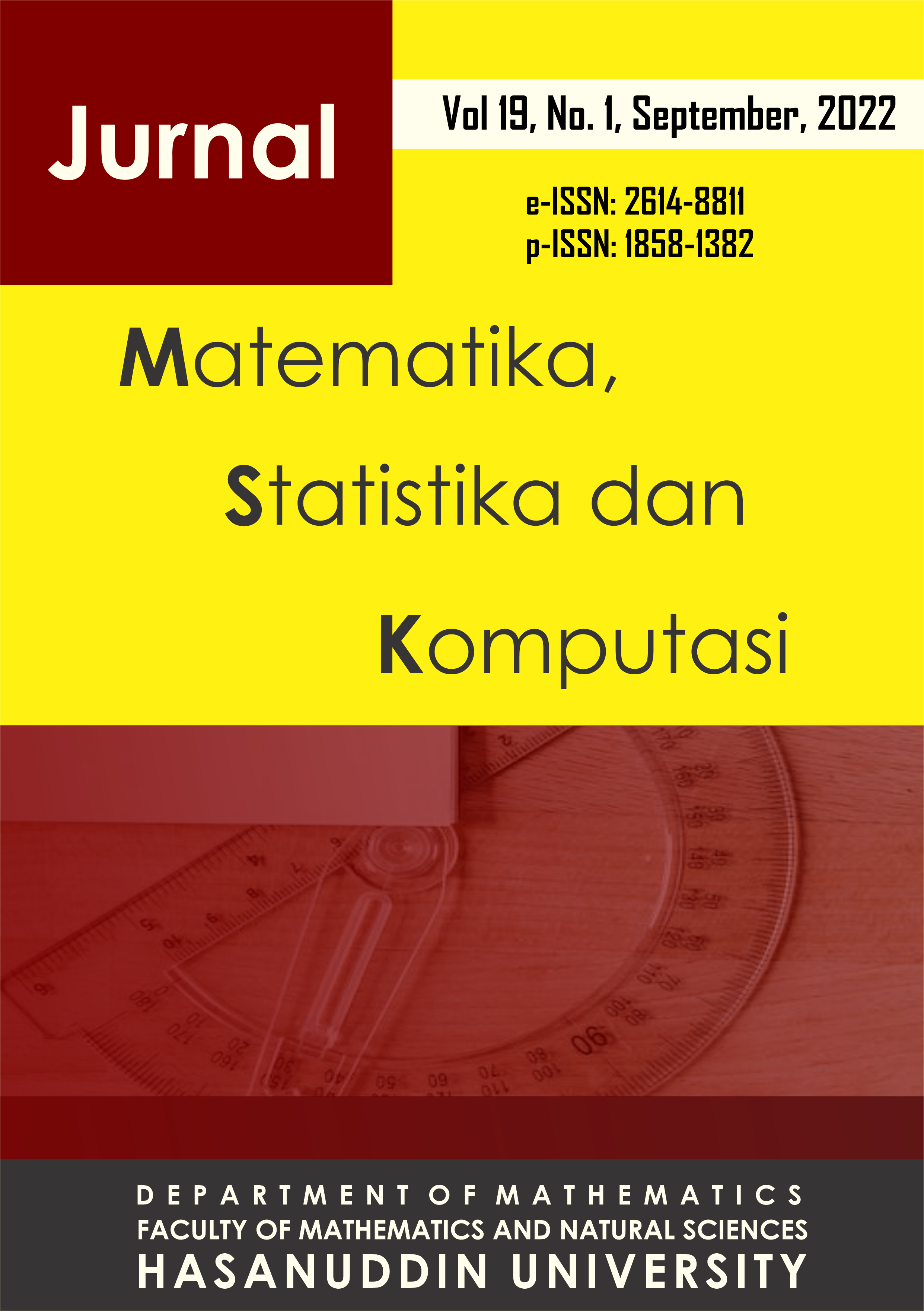Geographically Weighted Poisson Regression Model with Adaptive Bisquare Weighting Function (Case study: data on number of leprosy cases in Indonesia 2020)
DOI:
https://doi.org/10.20956/j.v19i1.21879Keywords:
Adaptive Bisquare, GCV, GWPR, Overdispersi, KustaAbstract
Abstract
Geographically Weighted Poisson Regression (GWPR) is a Poisson regression model which is applied on spatial data. The parameter estimation of GWPR is done in each observation location through spatial weighting. This study aims to determine the GWPR model of the number of leprosy cases in each province of Indonesia 2020 and to find the influencing factors. The research uses secondary data collected from Indonesian Ministry of Health and Central Statistics Agency. The spatial weighting is calculated by using the adaptive bisquare function, while the optimum bandwidth is determined by using Generalized Cross-Validation criteria (GCV). The parameter estimation of GWPR uses Maximum Likelihood Estimation (MLE) method. The result of research show that the closed form of Maximum Likelihood (ML) estimator can not be found analytically and that the approximation of ML estimator is found by using Newton-Raphson iterative method. Based on the parameter significance test of the GWPR model, the factors that influenced the number of leprosy cases locally are the percentage of households that have access to proper sanitation, population density, the percentage of people who experience health complaints and outpatient, the number of health workers, the percentage of poor people, the percentage of districts/cities that carry out healthy living community movement (GERMAS) and the percentage of habitable houses. While the factors that globally affected the number of leprosy cases are the percentage of households that have access to proper sanitation, population density, the percentage of people who experience health complaints and outpatient, the number of health workers, the percentage of poor people, the percentage of districts/cities that carry out GERMAS.
References
Astuti, R.D.K., Yasin, H., & Sugito., 2013. Aplikasi Model Regresi Spasial Untuk Pemodelan Angka Partisipasi Murni Jenjang Pendidikan SMA Sederajat di Provinsi Jawa Tengah. Jurnal GAUSSIAN. Vol. 2, No. 4, 375-384.
BPS., 2021. Statistik Indonesia 2021. Jakarta: Badan Pusat Statistik Republik Indonesia.
Caraka, R.E., & Yasin, H., 2017. Geographically Weighted Regression (GWR) Sebuah Pendekatan Regresi Geografis. Mobius: Yogyakarta.
Darnah., 2010. Menentukan Model Terbaik dalam Regresi Poisson dengan Menggunakan Koefisien Determinasi. Jurnal Matematika, Statistika, dan Komputasi. Vol. 6, No. 2, 59-71.
Darnah., 2011. Mengatasi Overdispersi pada Model Regresi Poisson dengan Generalized Poisson Regression I. Jurnal Eksponensial. Vol. 2, No. 2, 2085-7829.
Ernawati, Latra, I.N., dan Purhadi., 2016. Analisis Faktor-Faktor yang Memengaruhi Angka Prevalensi Penyakit Kusta di Jawa Timur dengan Pendekatan Spatial Durbin Model. Jurnal Sains dan Seni ITS. Vol. 5, No. 2, 2337-3520.
Fotheringham, A.S., Brundson, C., & Charlton, M., 2002. Geographically Weighted Regression: Analysis of Spatially Varying Relationship. John Wiley and Sons Ltd: England.
Hosmer, D.W., Lemeshow, J.S., & May, S., 2008. Applied Survival Analysis. Canada: John Wiley & Sons Inc.
Juniardi, L.C. & Salamah, M., 2015. Analisis Faktor-Faktor yang Mempengaruhi Jumlah Kasus Kusta di Jawa Timur pada Tahun 2013 Menggunakan Geographically Weighted Negative Binomial Regression (GWNBR). Jurnal Sains dan Seni ITS. Vol. 4, No. 1, 2337-3520.
Kementerian Kesehatan., 2012. Buku Pedoman Nasional Pemberantasan Penyakit Kusta. Jakarta: Kementerian Kesehatan.
Kementerian Kesehatan., 2019. Penanggulangan Kusta. Jakarta: Kementerian Kesehatan.
Kementerian Kesehatan., 2021. Profil Kesehatan Indonesia Tahun 2020. Jakarta: Kementerian Kesehatan.
Kleinbaum., 1988. Applied Regression Analysis and Other Multivariable Methods. Boston: PWS - KENT Publishing Company.
Kurniawan, I., 2017. Model Regresi Poisson Terbaik Menggunakan Zero-Inflated Poisson (ZIB) dan Zero-Inflated Negative Binomial (ZINB). Unnes Journal of Mathematics. Vol. 5, No. 1, 1-10.
Kustinah, N., 2012. Pemilihan Model Regresi Terbaik dengan Bayesian Information Criterion (BIC) (Skripsi). Universitas Sebelas Maret.
Lutfiani, N., 2017. Pemodelan Geographically Weighted Regression (GWR) dengan Fungsi Pembobot Kernel Gaussian dan Bi-Square (skripsi). Universitas Negeri Semarang.
McCullagh, P. & Nelder, J.A., 1989. Generalized Linear Models. London: Chapman & Hall.
Montgomery, D.C., Peck, E.A., & Vining, G.G., 1992. Introduction to Linear Regression Analysis. Toronto: John Wiley & Sons.
Mood, A.M., Graybil, F.A & Boes, D. C., 1974. Introduction to The Theory of Statistics. Third Edition. Singapura: McGraw-Hill.
Nakaya, T., Fotheringham, A.S., Brunsdon, C. dan Charlton, M., 2005. Geographically Weighted Poisson Regression for Disease Association Mapping. Statistics in Medicine. Vol. 24, No. 17, 2695-2717.
Noviani, D., Nur, I.M, & Wasono, R., 2014. Geographically Weighted Poisson Regression (GWPR) untuk Pemodelan Jumlah Penderita Kusta di Jawa Tengah. Jurnal Statistika. Vol. 2, No. 2.
Ulfa, Y.A., Soleh, A.M., dan Sartono, B., 2021. Handling of Overdispersion in the Poisson Regression Model with Negative Binomial for the Number of New Cases of Leprosy in Java. Indonesian Journal of Statistics and Its Applications. Vol. 5, No. 1, 2599-0802.
Wati, F., Suyitno, & Hayati, M.N., 2021. Pencegahan Penyakit Kusta di Lingkungan Hutan Tropis Lembab Kalimantan Melalui Pemodelan Geographically Weighted Poisson Regression. Jurnal EKSPONENSIAL. Vol. 12, No. 1, 2085-7829.
Downloads
Published
How to Cite
Issue
Section
License
Copyright (c) 2022 Author and publisher

This work is licensed under a Creative Commons Attribution 4.0 International License.

This work is licensed under a Creative Commons Attribution 4.0 International License.
Jurnal Matematika, Statistika dan Komputasi is an Open Access journal, all articles are distributed under the terms of the Creative Commons Attribution License, allowing third parties to copy and redistribute the material in any medium or format, transform, and build upon the material, provided the original work is properly cited and states its license. This license allows authors and readers to use all articles, data sets, graphics and appendices in data mining applications, search engines, web sites, blogs and other platforms by providing appropriate reference.







